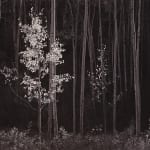Ansel Adams
Aspens, Northern NM, 1958
Silver Gelatin
13 x 16 1/2 in
One of the most important prints in Adams’ extant oeuvre, this vintage print of Adams’ masterpiece is one of two known examples bearing the uniquely soft, dreamy tones of his...
One of the most important prints in Adams’ extant oeuvre, this vintage print of Adams’ masterpiece is one of two known examples bearing the uniquely soft, dreamy tones of his early prints. The only other print of this size (13" x 16-1/2") that we have located is in the collection of MoMA, which featured it in their landmark show "Ansel Adams at 100”.
Another incredibly rare feature of this print is the "This is the American Earth" publication stamp on the reverse, which is only known to adorn one other print of this image. The "This is the American Earth" book was published in 1960 and features the Aspens image on the front cover, as well as later in the book as a double-page spread. This stamp was signed in ink by Adams, suggesting that he was approving its reproduction for the book; however, this hypothesis is not certain. There is also a BMFA 5 stamp, used no later than 1963. Due to the Agfa Brovira brand stamp on the print verso, which was abandoned in the late 1950's, this print would have certainly been made in 1958 or '59, prior to the publication of the aforementioned book, and predating Adams’ use of Oriental Seagull paper, which responded more to selenium toning. Judging by the tones, this is likely one of the first few prints of the image that were made, and epitomizes Adams’ original intention when viewing the New Mexico scene.
Another incredibly rare feature of this print is the "This is the American Earth" publication stamp on the reverse, which is only known to adorn one other print of this image. The "This is the American Earth" book was published in 1960 and features the Aspens image on the front cover, as well as later in the book as a double-page spread. This stamp was signed in ink by Adams, suggesting that he was approving its reproduction for the book; however, this hypothesis is not certain. There is also a BMFA 5 stamp, used no later than 1963. Due to the Agfa Brovira brand stamp on the print verso, which was abandoned in the late 1950's, this print would have certainly been made in 1958 or '59, prior to the publication of the aforementioned book, and predating Adams’ use of Oriental Seagull paper, which responded more to selenium toning. Judging by the tones, this is likely one of the first few prints of the image that were made, and epitomizes Adams’ original intention when viewing the New Mexico scene.



